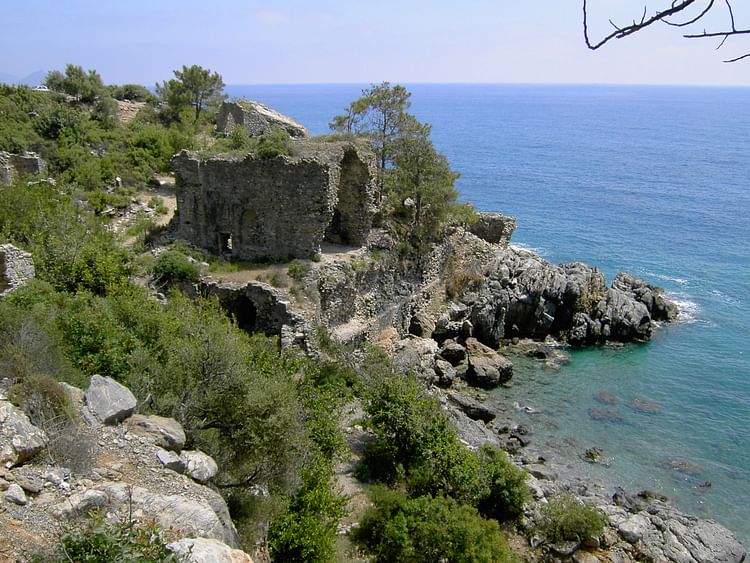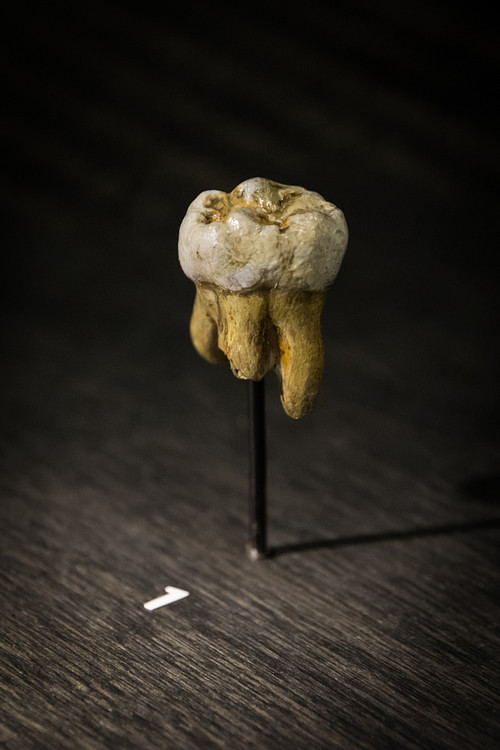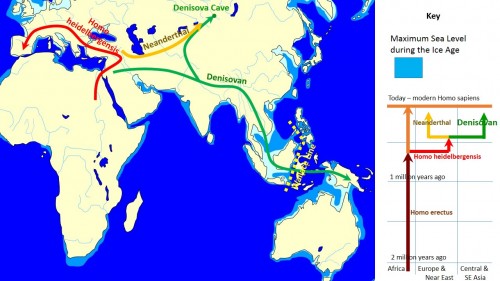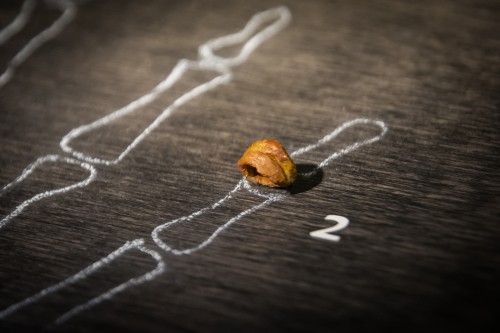Aytap › Denisovan » Ancient origins
Articles and Definitions › Contents
- Aytap › Ancient History
- Denisovan › Antique Origins
Ancient civilizations › Historical and archaeological sites
Aytap › Ancient History
Definition and Origins

Iotape, also known as Aytap, is a port city about 30km east of Alanya in Cilicia in Anatolia. The first archaeological evidence for human settlement at the site comes from the 1st century CE though there is a some concensus that it was earlier inhabited by tribes. It was originally founded by Antiochus IV of Commagene in 52 CE after he took control of Cilicia. Antiochis named the city for his wife Iotapa and it became Iotape (η Ιωτάπη).
The city is in an excellent place for settlement because of its natural harbour for trade and agriculture and its higher plateau where the settlement is protected from the sea and invasions from the coast. The natural harbour is made up of two bays measuring around 100m. Archaeological survey and excavation has uncovered ruins of an Acropolis with huge walls built around it to provide defense. Coins have been found indicating that Iotape included a mint which produced coins from the reign of Trajan to Valerian. There are also remains of Roman sewers, a necropolis and monumental tombs and sculptures, Roman baths, inscriptions and a rectangular Basilica to the East of the Acropolis. Temple ruins have also been excavated with surviving frescos within the city centre of the modern city.
Denisovan › Antique Origins
Definition and Origins

The Denisovans are an extinct group of fossil humans who, along with their sister group the Neanderthals, also share an ancestor with Homo sapiens. Thus far, they are known only from Denisova Cave in the Altai Mountains in Siberia, where a tooth was recently found that bumps up the number of known Denisovan individuals to a grand total of four. This newest specimen is also the oldest, and pushes back the timespan of these humans to at least 100,000 years ago, and maybe even beyond 150,000 years ago, fast-tracking this species into being amongst some of the oldest hominin remains that have so far been found in Central Asia. Denisovans lived at Denisova Cave until at least 48,000-60,000 years ago, indicating they called the Altai region their home (at least at certain times) over a period of tens of thousands of years. They are known to have interbred with Neanderthals; an unknown archaic hominin group that branched off from the human lineage at least one million years ago; and also with the ancestors of today's Melanesians living in Southeast Asia and Oceania. As this last event seems to have happened somewhere in Southeast Asia, far away from the Altai Mountains, we think the Denisovans may have been far more widespread than their currently only known resting place betrays.
DISCOVERY
Nestled in the Altai Mountains in Siberia, near the point where current-day Russia, Kazakhstan, China and Mongolia meet, is Denisova Cave, well known for human occupation stretching back as far as 280,000 years ago and showing signs of occupation by both Neanderthals and Homo sapiens. In 2008 CE, another human was added to this list when the finger bone of a young female was uncovered there and discovered to belong to its own species, dubbed the Denisovans, making the cave a true hotspot. The girl lived between 48,000-60,000 years ago, and paved the way for a somewhat older, male molar found in 2000 CE to be attributed to her species, too. The only other two fossils to receive the Denisovan name tag so far are two further molars: one permanent molar belonging to a male, found in 2010 CE; and, in a recent discovery, a deciduous molar belonging to a very young girl who lived at least 100,000 years ago and possibly even past 150,000 years ago. This greatly pushes back the confirmed time span of this species.

Denisova Cave
SCRATCHING THE SURFACE
Impressively, despite the ever so slightly scarce amount of material associated with the Denisovans, both archaeology and science have come to the rescue and are allowing us to uncover some initial information regarding this species. Sadly, we cannot reconstruct their faces or bodies as of yet, but the three molars that were found show that the Denisovans had very large and robust teeth, which fit in a lot better with older hominins such as Homo erectus, Homo habilis, and even the Australopithecines than they do with our own tiny teeth, or even with the slightly bulkier Neanderthal ones. Big teeth seems to have been a typically Denisovan feature, then - at least for the ones living in the Altai Mountains. Regarding the rest of their features, DNA from our available Denisovans paints a picture of brown eyes set against dark skin, with brown hair topping things off, but, considering Denisovans were probably more widespread, it is likely that more variety existed.
Like their contemporaries, the Denisovans seem to have made tools. The finger bone belonging to the young girl was found in a layer which also contains tools such as micro blades as well as polished stone ornaments that scream Upper Palaeolithic industry (which is normally connected with modern humans), but also side scrapers and Levallois blanks (retouched hand axes made from carefully prepared cores) that tie in with the Middle Palaeolithic. As of yet, both the details and broader features of Denisovan tool use are hard to map out, though.
THEY ARE A SISTER GROUP TO THE NEANDERTHALS & SHARE A COMMON ANCESTOR WITH THEM - THE TWO GROUPS DIVERGED BETWEEN C. 190,000-C. 470,000 YEARS AGO.
Most studies published on these guys are of the genetic kind, however, and can tell us such neat things as, for example, how diverse the Denisovan population may have been. Strikingly, even though all of our current Denisovan fossils only stem from a single location – Denisova Cave – they seem to have been at least equally diverse as the Neanderthals were across their almost arrogantly widespread geographical range, as well as falling within the lower range of diversity seen in modern humans today. Of course, this Altai-based group of Denisovans could conceivably have been fairly isolated, and it is entirely possible that the Denisovans over their whole suggested geographical range may have been more varied. Some strokes of luck in finding additional fossils would be very, very welcome.
The wonderful world of genetics is also narrowing down where the Denisovans fit on the human lineage. It is clear that they are a sister group to the Neanderthals and share a common ancestor with them - the two groups diverged between an estimated 430,000-473,000 years ago – but also that this Neanderthal-Denisovan branch shares an ancestor with our own Homo sapiens species. The branch that would lead towards both Denisovans and Neanderthals on the one hand, and the branch that would develop into modern humans on the other hand, split off from each other around an estimated 765,000-550,000 years ago. This evolutionary connection is only the beginning, though – the extent of our ties with both of these groups makes for even better news headlines.

Spread and Evolution of Denisovans
WEB OF CONNECTED HUMANS
By now, evidence is positively piling up that is finally overthrowing the old idea of linear evolution (one species evolves into the next, which evolves into the next, and so forth). As John Hawks suggests, the evolutionary history of the genus Homo probably looked more like a river delta, with streams weaving in and out, connecting and disconnecting, some branching off and landing in the sand and others continuing on. Different groups of humans met and interbred at various times and places, with genes being exchanged all over the place. Our ever-helpful Denisovans have greatly served to underpin this notion because apart from the already known gene flow from Neanderthals into non-African modern humans (~2% Neanderthal ancestry), we now know there was also gene flow from Neanderthals into Denisovans; from an unknown archaic human into the Denisovans;and, around an estimated 44,000-54,000 years ago, from Denisovans into the ancestors of present-day Melanesians living on Southeast Asian islands and in Oceania (~2-4% Denisovan ancestry). This Denisovan component also occurs in diluted version across the Asian mainland and the Americas, and at lower levels it is widespread among modern humans in general, thanks to our wanderlust and desire to migrate all over the place.
WHEN HOMO SAPIENS BECAME THE NEW KID ON THE EURASIAN BLOCK, THEY GENETICALLY BENEFITED FROM THE EXCHANGE WITH THE LONG SINCE ESTABLISHED NEANDERTHALS & DENISOVANS.
Evolutionary geneticist and ancient-DNA pioneer Svante Pääbo summarises this apparent chaos in suggesting that '… our ancestors were part of a web of now-extinct populations linked by limited, but intermittent or sometimes perhaps even persistent, gene flow.' (Pääbo, S. 'The diverse origins of the human gene pool', 313). We know when it comes to the Neanderthal-Denisovan mixing, at least, that the circumstances were certainly right: the Denisovan occupation of Denisova Cave overlaps with when Neanderthals are known to have made themselves comfortable in this same cave, too, which makes it easy to envisage these two groups (literally) bumping into each other from time to time. Moreover, it is because of the big chunk of Denisovan DNA in Melanesians that we think they must have been more widespread than just the Altai Mountains.
The cool thing is, when the main wave of Homo sapiens that journeyed out of Africa around 55,000 years ago became the new kid on the Eurasian block, they genetically benefited from the exchange with the long since established Neanderthals and Denisovans. We already knew that Sapiens stole some skin- and hair colour genes that were more suited to the northern ranges of the world when they interbred with Neanderthals, but they also gained a nice immune system boost from both of these species, who were already very much adapted to local Eurasian pathogens while Sapiens was not. This would have helped defend modern humans against the new array of parasites and bacteria. More traits courtesy of the Denisovan mixing are coming to the fore, too, such as the ability of Tibetans to cope with dizzyingly high altitudes.

Denisovan finger bone
However, just like with the cosy connection with the Neanderthals, it seems the Sapiens-Denisovan connection also caused some problems. Certain bits of DNA inherited from them turned out to be harmful and were aggressively selected against, and it seems male mixed children may even have been sterile, indicating that although these groups of humans shared ancestors and could obviously make babies together, they were actually different enough to only just be biologically compatible.
THE FUTURE
It is incredible that through a few fossils and accompanying titbits belonging to only four individuals, from one cave nestled high in the Siberian Altai Mountains, scientists have managed to extract enough information to fill an entire definition on this website. To really paint a proper picture of who the Denisovans were, what it would be like to stare into their faces, how tall or stocky they were, and what their lifestyle and culture was actually like, how far spread out they were across the world and who exactly they bumped into, we need to get digging and get very lucky. More Denisovan-related finds would help to balance out our information and stretch it beyond mostly genetics. Bring on the future so we can fill in the past, please.
LICENSE:
Article based on information obtained from these sources:with permission from the Website Ancient History Encyclopedia
Content is available under License Creative Commons: Attribution-NonCommercial-ShareAlike 3.0 Unported. CC-BY-NC-SA License